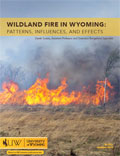 apply now
apply now University of Wyoming Extension
Department #3354
1000 E. University Ave.
Laramie, WY 82071
Phone: (307) 766-5124
Email: uwext@uwyo.edu




 | Wildland Fire in Wyoming: Patterns, Influences, and Effects | |
Publication #: B-1271 Publication Author(s): |
Description:
Fire on North American rangelands and forests has been a regular and formative process for centuries. One of the most recognized fires of modern history occurred largely in Wyoming in 1988 when more than a third (>700,000 acres) of Yellowstone National Park burned due to high fuel loads, high winds, and drought conditions. Although this fire was considered a natural resource disaster by some, this type of infrequent and large fire may have been the characteristic fire pattern for some plant communities in the Rocky Mountains (Baker 2009). It is also important to consider that the influence of wildland fire on plants, animals, and humans is not limited to North America, because it is a regular disturbance on other continents and is considered a global process linked to climate patterns and human activity (Carmona-Morena and others 2005; Flannigan and others 2009; Bowman and Murphy 2011). Appropriately, fire is feared because of the threat to property destruction and death. In contrast to that fear, fire is also recognized as an important disturbance that dictates vegetation patterns and has implications for wildlife habitat and livestock production. It has been proposed that fire can be as important as soil and water but at different time and space scales. In this bulletin, I examine two types of wildland fire: wildfires that burn unintentionally and prescribed fires that are intentionally set by humans to achieve some land management objective. I also review 1) influence of drought and plant communities on the pattern of fire in Wyoming; 2) the influence of fire weather, season, and fuel characteristics on fire behavior, 3) how to calculate and measure fire intensity and severity; 4) prescriptions and precautions for prescribed burning; and 5) fire effects and interactions with plants, soils, livestock, wildlife, and bark beetle outbreaks.
Printing Problems? If your pdf is printing with odd characters, save the file to your computer. Open the file with Adobe Reader. The file should now print correctly. If you are still having problems, please, contact us at Publications Support or call (307) 766-5157.
Need Further Assistance? Contact Publications Support or call (307) 766-5157.
University of Wyoming Extension
Department #3354
1000 E. University Ave.
Laramie, WY 82071
Phone: (307) 766-5124
Email: uwext@uwyo.edu



